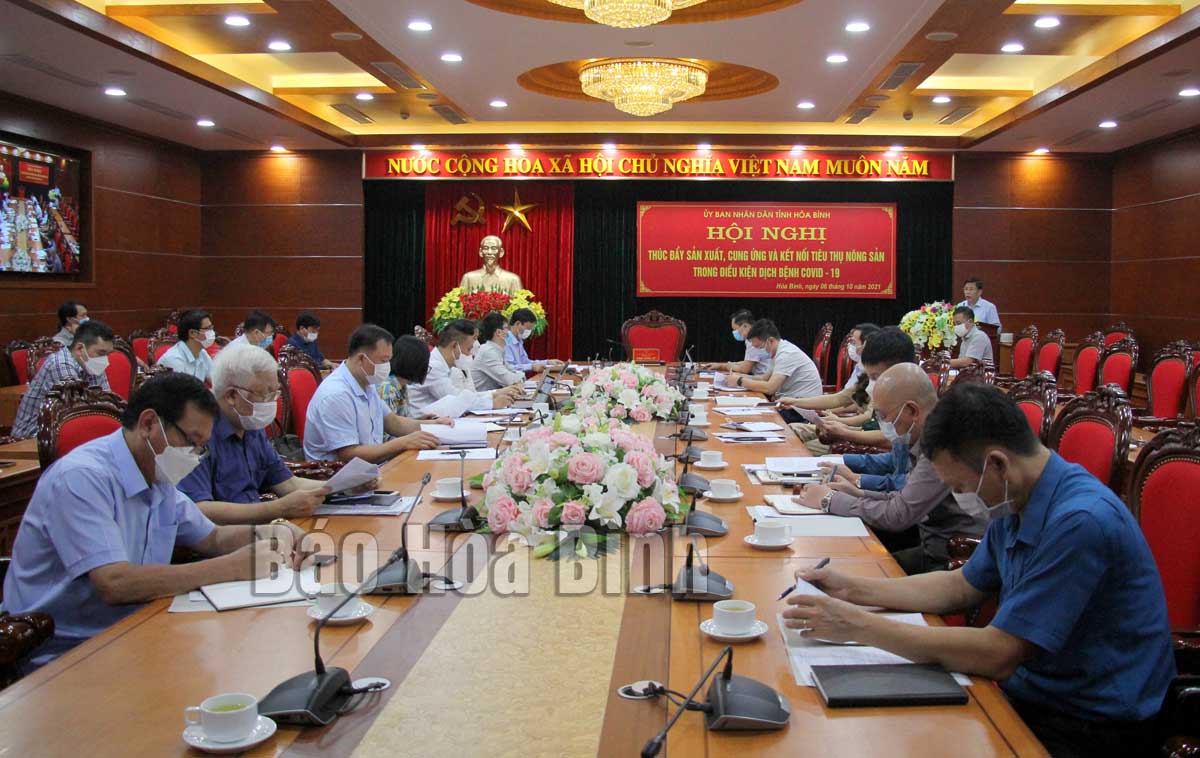
(HBO) – The Hoa Binh provincial People’s Committee has held a teleconference to promote the production and supply of agricultural products along with sale connectivity amid the COVID-19 pandemic. Vice Chairman of the provincial People’s Committee Dinh Cong Su chaired the event, which was attended by representatives of relevant departments, sectors, localities, and businesses.

Vice
Chairman of the provincial People’s Committee Dinh Cong Su delivers the closing
remarks at the meeting.
Participants in the October 6 meeting discussed
measures for tackling obstacles to farm produce production and sale from now to
the end of the year, including boosting production under value chains, strictly
controlling the production and circulation of agricultural and food products in
Hoa Binh, ensuring food safety, and avoiding disruptions to supply chains.
In his closing remarks, Vice Chairman of the
provincial People’s Committee Dinh Cong Su said in the time ahead, enterprises,
cooperatives, producers and farmer households need to work closely with
departments, sectors, and localities to update information about quality
products in order to meet consumer demand and introduce those products to
consumers in other localities nationwide. They should also hold frequent events
to instruct producers and traders how to use information technology and sell
farm produce on e-commerce platforms.
He asked departments, sectors, and localities in
Hoa Binh to fulfill their duties with a focus on keeping production chains uninterrupted,
ensuring sufficient supply to meet demand for farm produce in and outside the
province as well as materials for export processing in the year-end months,
connect material production zones with processing and preservation
establishments to raise agricultural products’ value, build high-tech farming
models, and provide production unit codes for plant and animal farming
establishments.
Besides, they need to prioritise COVID-19
vaccination for personnel who farm, harvest, and process agricultural products;
carry out support policies to help farmers and producers resume production in
the localities subject to social distancing; increase trade promotion, business
matching, and assistance for farmers, enterprises, and cooperatives to sell
agricultural products via e-commerce platforms; instruct businesses in applying
anti-pandemic measures; and create the best possible conditions for the
transportation of input materials for agricultural production, according to the
official.
The Standing Board of the Hoa Binh provincial Party Committee met on March 18 to review and guide major investment projects aimed at boosting local socio-economic development.
The air is thick with the hum of drills and the clatter of machinery as the Hoa Binh – Moc Chau expressway takes shape amid the rugged terrain. Welding sparks illuminate the faces of workers, and concrete mixers churn relentlessly, laying fresh pavement on the newly-carved road. The construction site buzzes with a palpable sense of urgency, particularly in Hoa Binh province where the expressway's future is being forged.
The northern province of Hoa Binh, with over 467,000 hectares of natural forest and more than 100,000 hectares of production forest, holds significant potential for carbon credit market development.
Replacing substandard houses with more sturdy ones by June 30 is the direction given by Nguyen Phi Long, alternate member of the Party Central Committee and Secretary of the Hoa Binh provincial Party Committee, at a meeting held in early March by the provincial Steering Committee for the programme to eliminate temporary and dilapidated houses for the needy.
Recognising digital transformation as an inevitable trend, authorities and agencies in Hoa Binh have made great efforts in the work by focusing on three core pillars - digital government, digital society, and digital economy, resulting in enhanced competitiveness, improved investment climate, and ensured economic and social welfare.
In recent years, Da Bac district has improved administrative reform with a one-stop shop mechanism, streamlined inter-agency procedures, and a shift to digital platforms. These efforts have enhanced public service efficiency and contributed to local socio-economic development.



